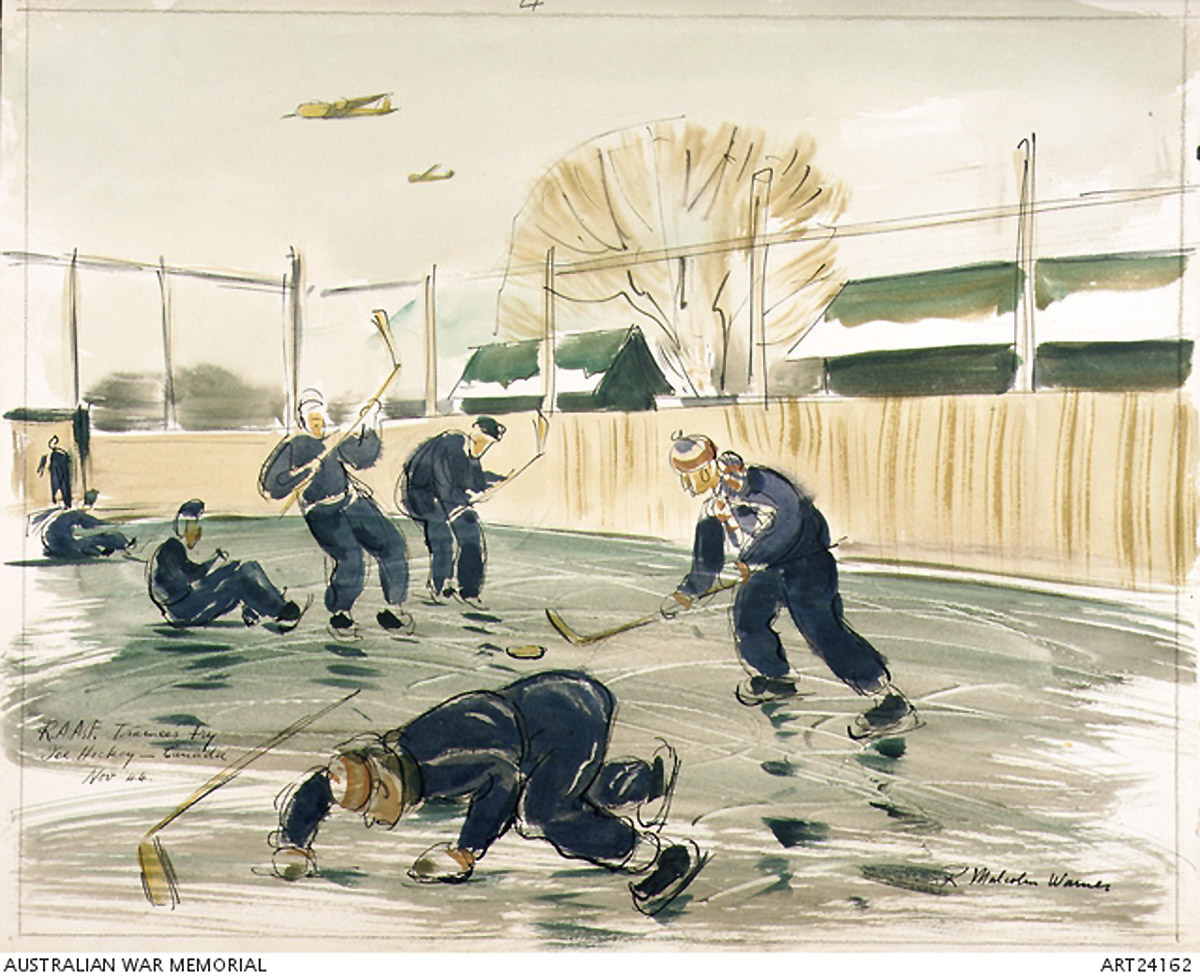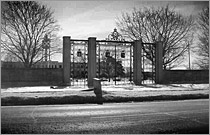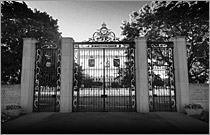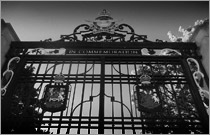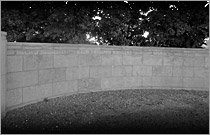Legends
home
From a desert, from the driest continent, from this land at the opposite end of the globe ...
... as remote as could be in the hockey world ...
... came one of the world’s oldest winter sports trophies.
A cool tradition, a dream of champions, and a story we owe it to our children to tell.
Legends of Australian Ice.
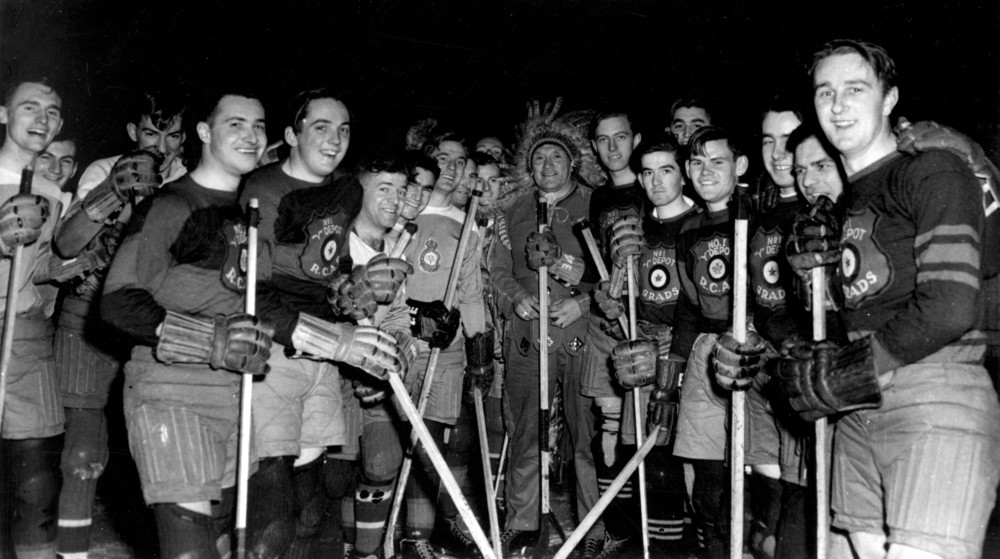
AIRMEN FROM AUSTRALIA AND NEW ZEALAND, trainees under the Empire Training Scheme, on the eve of its fourth birthday, played an ice hockey game in Montreal Forum, Canada while attached to an RCAF embarkation depot near Montreal. None had ever been on skates before, and their antics caused intense amusement to onlookers, but the boys can at east say they have played Canada's national winter game. RAAF men in picture are: Sgt William Dettman (left), Sgt William Crossman (second from left), and, reading from extreme right: Sgt. W. White (Tas), Cyril Irwin (Sydney NSW), Dave Moore (Adelaide, SA), Johnny Gillespie (Sydney), K. Hendy (Sydney); Paul Johnson (Sydney), and Reg Lockheed (Sydney). In the centre is Sgt Buck Tahamont (Montreal, Canada) dressed in Indian regalia. Canadian Army photo published in The Argus, Melbourne, Vic, Friday 28 April 1944, p 9. This image: State Library Victoria.
[ HOCKEY ] The Gates of Freedom
Victoria Arena, Calgary, 1940s
![]() It is with deep appreciation that I accept, on behalf of the Government and people of Canada, this magnificent gift from the governments of the United Kingdom, Australia and New Zealand. These gates will remind us of the sacrifice of those who gave their lives so that we may live in freedom. They will also stand as an enduring symbol of unity of spirit among the peoples of the British Commonwealth. The gates will be a reminder to those in the world today who harbour aggressive intentions. [2]
Canadian Prime Minister Louis St Laurent on receiving the four keys to the four gates at CFB Trenton, 1949
It is with deep appreciation that I accept, on behalf of the Government and people of Canada, this magnificent gift from the governments of the United Kingdom, Australia and New Zealand. These gates will remind us of the sacrifice of those who gave their lives so that we may live in freedom. They will also stand as an enduring symbol of unity of spirit among the peoples of the British Commonwealth. The gates will be a reminder to those in the world today who harbour aggressive intentions. [2]
Canadian Prime Minister Louis St Laurent on receiving the four keys to the four gates at CFB Trenton, 1949
![]() We cannot bring our slain soldiers back from the dead, nor restore them to their families. Grieving and eulogizing, cannot be all that we do. The most important consideration in our minds, if we truly value the Anzac spirit, should be to guard against slain soldiers in the future. Not by steadfastly refusing to risk the lives of our military, for there will be causes important enough to risk lives for. But by ensuring, with all our might, that if someone is willing to risk their life as a professional soldier, they will be able to trust that their fellow citizens have made their training, their equipment and their strategy the top priority. If our most special day is dedicated to remembering wars past and guarding against the tragic repetition, then we must focus our efforts on studying the future of conflict. War is not inevitable, nor necessary. [3]
James Brown, Anzac's Long Shadow: The cost of our national obsession, 2014
We cannot bring our slain soldiers back from the dead, nor restore them to their families. Grieving and eulogizing, cannot be all that we do. The most important consideration in our minds, if we truly value the Anzac spirit, should be to guard against slain soldiers in the future. Not by steadfastly refusing to risk the lives of our military, for there will be causes important enough to risk lives for. But by ensuring, with all our might, that if someone is willing to risk their life as a professional soldier, they will be able to trust that their fellow citizens have made their training, their equipment and their strategy the top priority. If our most special day is dedicated to remembering wars past and guarding against the tragic repetition, then we must focus our efforts on studying the future of conflict. War is not inevitable, nor necessary. [3]
James Brown, Anzac's Long Shadow: The cost of our national obsession, 2014
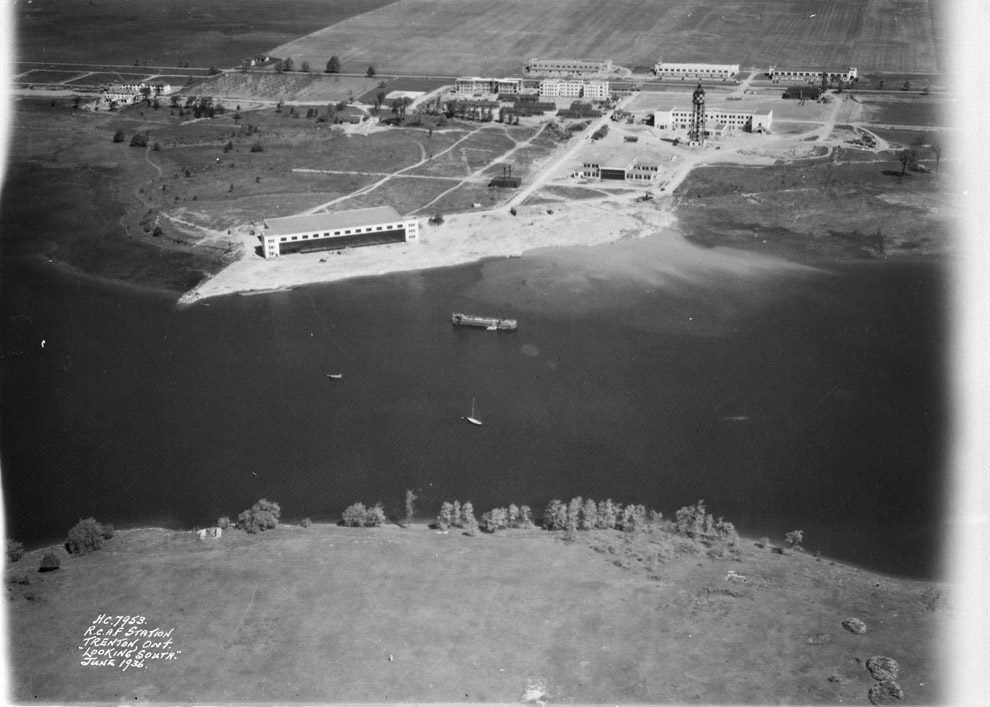 CFB Trenton, 1936
CFB Trenton, 1936
THE BAY OF QUINTE looked like the mark of Zorro to the paratroopers of the C-17 Globemaster that was now banking sharply to align with the approach axis of Canadian Forces Base Trenton. The four gates standing on old Highway 2 — each emblazoned with the crest of Canada, Australia, New Zealand, or The United Kingdom — led to the base headquarters building and the parade square. But the paratroopers knew that they really led to freedom. For it was there that many airmen, including thousands of Anzacs, received their aircrew wings before joining the fight against Nazi Germany. And there that an imposing ceremony took place on September 30th 1949.
Representatives of the four nations unlocked the gate bearing the crest of their country. Sentries officially opened them for the first time. Four keys were presented to Canadian Prime Minister Louis St Laurent. Silver plaques were presented to representatives of the Royal Air Force, Royal Australian Air Force, Royal New Zealand Air Force and the United States Air Force to "show the appreciation of the Royal Canadian Air Force for the cooperation and assistance rendered by our Allies during the operation of the Air Training Plan". Then the heavens were torn apart by the Vampire jet fighters of RCAF 410 Squadron displaying formation and single-aircraft aerobatics, and Harvard aircraft spelling out "R C A F". A little later in October 1951, Princess Elizabeth — the future Queen Elizabeth II — dedicated the gates and was presented with four keys.
The town of Trenton Ontario is the midpoint between Ottawa and Toronto. Today, CFB Trenton is its major employer and the hub for Canadian Forces air transport operations, locally and abroad. During the Second World War it was the largest training centre in the network of "The Plan", with more than 130,000 air crew from Australia, Canada, New Zealand and the United Kingdom training under it from 1940 to 1945. The gates commemorate the signing of an agreement in December 1939 to conduct the majority of all allied aircrew training in Canada. Its success was noted by leaders such as Sir Winston Churchill and President Franklin D Roosevelt, who gave Canada the proud title "the aerodrome of democracy". Known as the British Commonwealth Air Training Plan, the Empire Training Scheme, and many other variants, most people simply called it "The Plan". You might, however, prefer to commemorate it with the words of F L Hamilton, written sixty-eight years ago.
None who watched or took part in the ice hockey tests between aircrew trainees from New Zealand and Australia which were played in Canada during World War II will forget them. Canada was barred from the contests by a single rule "no player will ever have worn ice skates." To find a native eligible under that rule, one would have to obtain the services of children still unable to walk. This epic series was centred in Calgary, Alberta. In all the flying training schools and wireless schools, the natural competitive spirit between the Aussies and Kiwis was fostered, primarily for exam results, but carried outside the classroom in the form of snow fights, tall stories and what have you. Various hospitable Canadian families took up the battle, depending upon the country of origin of their particular adopted sons.
The imaginative promoter of Calgary's huge indoor ice stadium saw the opportunity for a very interesting experiment — and so the stirring Kiwi versus Aussie ice hockey series was born. Each Dominion set about choosing a team, and no matter what the extent of a candidate's theoretical knowledge of the game, he was passed over for a more pacy crawler or "slitherer." Tests were carried out on the station rinks to determine the fastest all-four crawlers. Beef and brawn, too, were desirable in case of a not unlikely fracas.
So the two teams were picked, trained to the minute in every underhanded trick known to the boys, but still not having the remotest idea as to the whys and wherefors of ice skating. The first match was widely advertised throughout the town as a curtain raiser to the Chicago Blackhawks, an American team, and the Toronto Redwings. Bookings, heavy in the normal course of events, rose to a record high. The big night came, and the Kiwi and Aussie barrackers formed in blocks to stir tiring participants on to fresh onslaughts. The central and side umpires skated out on to the rink, a whistle was blown.
The two teams appeared swathed in the great ice hockey protective gear, pads, gloves, chest protectors and wearing the advertised colours. But instead of the keen "Let's get at them" attitude of regular ice hockey teams, these two sets were led out in a most undignified manner. The loud-speaker system announced that "as a time-saving feature" each player would be helped to his position by a member of the stadium staff, despite indignant protests from independent and over confident team members. The teams were placed in their positions, the second whistle was blown, the attendants let go their charges and skated off the rink.
Immediately dull thuds resounded through the stadium as players' untrained legs gave way and forms were prostrated on the ice. Anyone unfortunate enough to remain standing was promptly tripped and brought to the apparently recognised level. In each goalmouth opposing goalies had decided to prevent a score by lying inert across the goalmouth. At the centre, the two pivot men had scrambled to all fours and a terrific race ensued for the ever-elusive puck.
Tremendous cries rent the air as the Kiwi gained possession. He promptly threw away his stick, tucked the puck inside his guernsey, and commenced his dog-like slither towards the goalmouth. Small chance he had, though, as two tremendous Aussies grabbed a leg apiece, and sent him spinning down the ice whence he had come. He cannoned into three team mates who endeavoured unsuccessfully to extricate themselves from a real scrum, only to find four scrambling bodies hurled into the fray — the Aussies had arrived.
The exhausted pivot man had his guernsey ripped from him, and the little puck hit the ice again. A wild swing sent it flying down field to the Aussie goal, where the astounded Kiwi goalie all but swallowed it as he lay, mouth open in amazement. He grabbed it, and with great presence of mind threw it the length of the field. A team mate rose from the ice porpoise fashion, and hurled it into the goal net as he fell backwards, legs thrashing the air. "A goal, you _______ beaut!" Hit or Throw? Unfortunately it was disallowed. The umpire vainly attempted to point out: "The puck must be hit through the goalmouth." An all-in fight now developed, with no holds barred.
So the match continued, with no-one seeing the puck again. Bodies rocketed out from the centre brawl; sticks were splintered to nothingness; pads were wielded heavily as the Kiwis fought for recognition of the goal, and Aussies attempted to deny it. The game ended with the ever obliging attendants dragging a hotly-remonstrative Aussie or a triumphant Kiwi from the rink amid roars of laughter from the delighted audience. Back in their homelands today, the players and spectators still argue as to who rightly deserves the "ice hockey ashes" - Kiwis by a goal, or Aussies on a foul.
![]()
Bibliography:
[1] The West Australian, Perth WA, Saturday 3 May 1947, Heat On Ice by F L Hamilton, p 5
[2] Royal Canadian Air Force, March 25 2015, Trenton Gates Memorialize Wartime Air Training Plan, By Royal Canadian Air Force Public Affairs
[3] Anzac's Long Shadow: The cost of our national obsession, James Brown, 2014.
[Slideshow above] The music video is Tom Waits live in 1977. (Bon Jovi and Rod Stewart covers don't quite cut it.) The image is by Ralph Malcolm Warner (1902- 1966) who was appointed Australia's Official War Artist in 1943, covering the activities of the RAAF in Canada, United States and the Bahamas. In 1945 Warner continued to work as a war artist recording civil and industrial war efforts and food production in areas of New South Wales and Victoria. After the war he returned to commercial art, designing posters, murals and postage stamps and illustrating books.
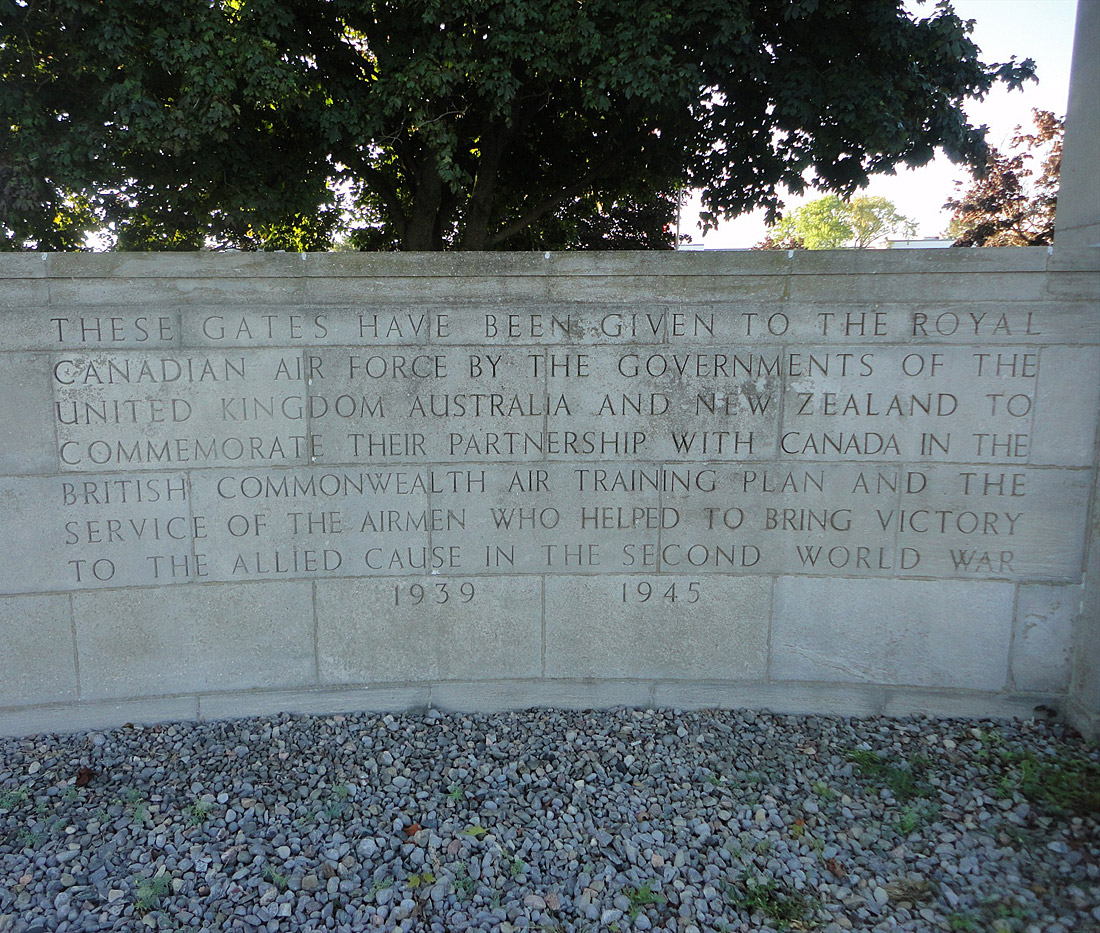
Royal Canadian Air Force Memorial Gates - CFB Trenton ON
